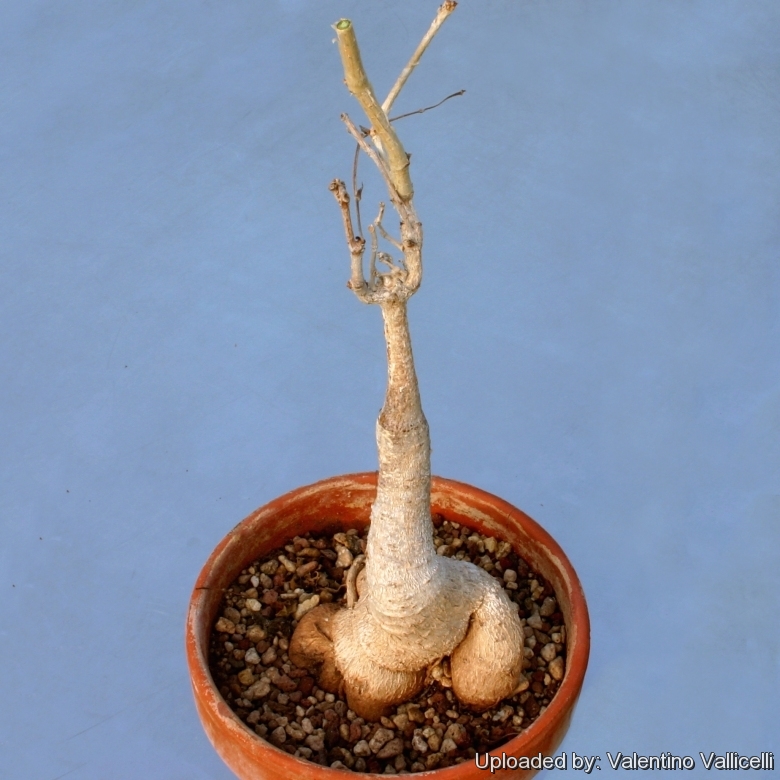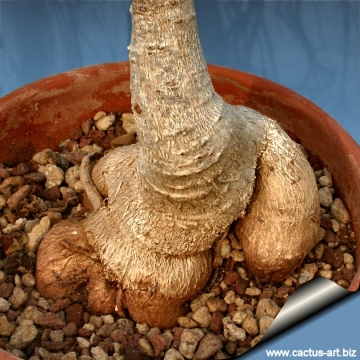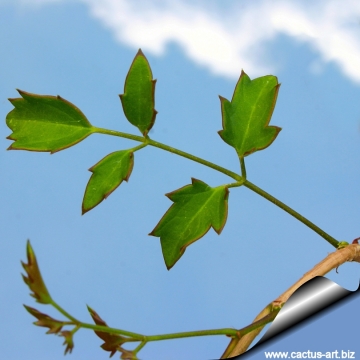
Cyphostemma elephantopus Photo by: Valentino Vallicelli
One of the most spectacular of the genus with both a discoid tuber and pachycaul stem with age. Fanciers of succulent plants consider cyphostemmas to be eminently desirable
Origin and Habitat: Madagascar (Toliara)
Synonyms:
Common Names include:
ENGLISH: Elephant-foot Grape Tree
Description: Weird but ornamental herbaceous perennial caudiciform vine, with massive, above-ground flask-like caudex with a tapering shape, a bit like an elephant’s tusk.
Rottstock (Caudex): This species has a very broad, fat, underground root system. This complex root system gradually tapers into a thickened, conical or disc-shaped caudex that can grow up to 60/200cm across. The caudex is woody, smooth, dark brown with concentric rings and looks like a big brown rock. In habitat this underground storage organ can attain surprisingly large dimensions with a water reservoir capacity up to 100-200 (or more) litres.
Stem: The rambling vines are succulent and reach about the height of two meters in cultivation (but in habitat they can reach the length of more than 20 m.)
Leaves: Fleshy, serrated (tri-lobed) and deciduous.
Flowers: Yellowish-green to glaucous green in a loose inflorescence.
Bibliography: Major references and further lectures
1)Umberto Quattrocchi “CRC World Dictionary of Medicinal and Poisonous Plants: Common Names, Scientific Names, Eponyms, Synonyms, and Etymology” (5 Volume Set) CRC Press, 03/May/2012
2) Gordon Rowley “Caudiciform and Pachycaul Succulents: Pachycauls, Bottle-,Barrel-And Elephant-Trees and Their Kin a Collector's Miscellany” Strawberry Press. June 1st 1987
3) Werner Rauh “The Wonderful World of Succulents: Cultivation and Description of Selected Succulent Plants Other Than Cacti” Smithsonian Institution Press, 1984
 Cyphostemma elephantopus Photo by: Cactus Art
Cyphostemma elephantopus Photo by: Cactus Art Cyphostemma elephantopus Photo by: Cactus Art
Cyphostemma elephantopus Photo by: Cactus Art Cyphostemma elephantopus Photo by: Cactus Art
Cyphostemma elephantopus Photo by: Cactus ArtSend a photo of this plant.The gallery now contains thousands of pictures, however it is possible to do even more. We are, of course, seeking photos of species not yet shown in the gallery but not only that, we are also looking for better pictures than those already present.
Read More... Cultivation and Propagation: Cyphostemma elephantopusSN|21898]]SN|21898]]. It should make an interesting addition to a collection. It is suited to greenhouse culture, but does well outdoors in subtropical climates. It doesn't like a wet winter, but will survive.
Growth rate: It grows well, though very slowly, but it possible to increase the speed of growth to some extent by providing adequate amount of water, warmth, and fertilizer during the active growing season, but it’s susceptible to rotting if too wet.
Exposure: It needs Full sun to light shade, but the caudex should be in the shade, while the leaves prefer the sun. Avoid direct blasting sun in summer.
Soil: It needs a a rich, very well drained potting medium (add pumice, vulcanite, and perlite).
Waterings: It should be watered plentifully in Summer and kept drier in Winter. This species like all pachycaul succulent species of Cyphostemma, is sensitive to excess moisture, and should be kept on the dry side. It rot easily and do NOT like a lot of water when it has no leaves.
Frost tolerance: Due to its African origin keep warm in winter, the minimum safe average temperature is 12°C, although it can go lower for short periods. It can be grown outdoors in frost-free climates, need anyway to kept above 2°C and dry in winter. Can't stand any frost.
Maintenance: Repot every two years. It like pots with generous drain holes. Once this plant is established in its new pot, it should be cut back in height to encourage branching, to maintain an attractive shape and to ensure caudex habit. If pruned and kept somewhat pot bound, it can be maintained at a manageable size, depending on what ''manageable size'' means to you.
Propagation: The plants for decoration are grown from seed since they develop a perfect caudex. The seeds that must be prepared, aged and scarified, and even then germination is uncertain (cuttings are possible, but don't generally produce a caudex).













